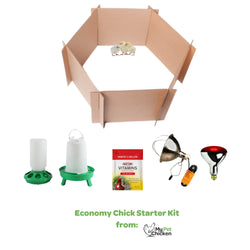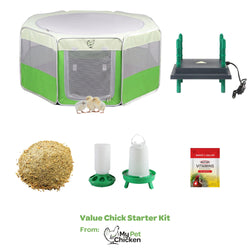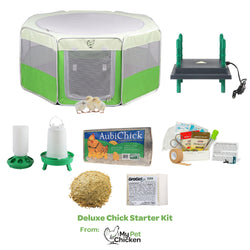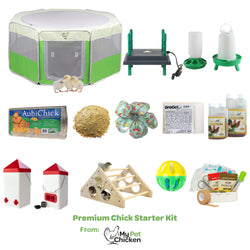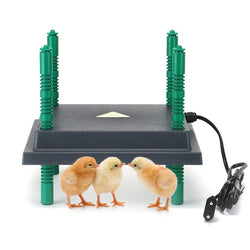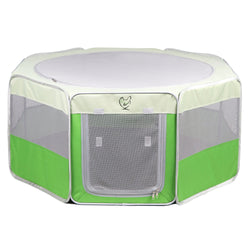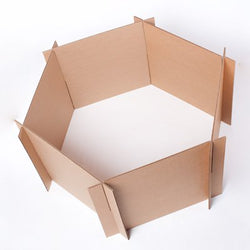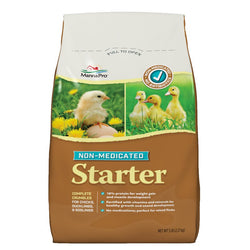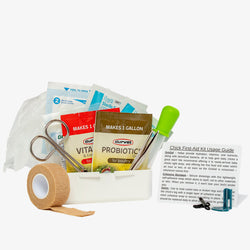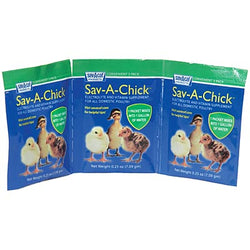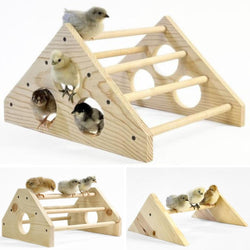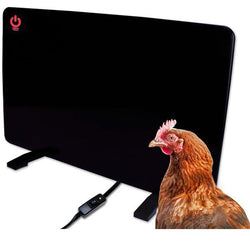How do I care for guinea keets?
Back to blog
For tick control and flock protection, there's nothing like guinea fowl! If you choose to raise guineas, the basic instructions for caring for baby chicks also apply to guinea keets, but there are a few special points of consideration that we will discuss below. You can see our basic chick care instructions here: Chicken Care Guide Chapter 4: Caring for Baby Chicks
Shipped guinea keets will be 1-4 days old when they arrive, and they will need to be put in a pre-warmed brooder immediately, especially if they are showing signs of stress from shipping (like looking tired and weak).
We do not recommend wire flooring at this young age because it is a good possibility that their legs will get caught in the wire. Also, do not use slick bedding, as keets that develop spraddle leg are not as likely to recover as chicks and waterfowl. Your best bedding choice will likely be wood shavings that are too large for the keets to ingest. Do not use anything small enough for them to eat--like sawdust--as they are likely to eat it and could plug themselves up.

Heat
It may be wise to put the nest pad that comes in the shipping box under the brooder's heat source as a gentle reminder to the birds: "Here's the place to warm up!" Since they are more prone to getting chilled than chicks, watch them carefully for piling up under the heat source. If they all scramble to be under the heater at the same time, they can trample each other. The temperature under your heater may need to be slightly higher for the smaller-bodied birds--usually 99- 100 degrees F for the first week--then lower it 5 degrees per week until about 70 degrees F. The temperature must be closely monitored and you must take the time of year, ambient temperature, day/night temperature fluctuations, and quality of the structure in which the keets are being brooded into account as these can affect the stability of the temperature in the brooder. Brooding guinea keets inside a well-insulated, draft-free, climate-controlled building is preferred to prevent losses.
If you have not raised guineas before and are using a heat lamp, a thermometer is highly recommended so that you can make sure the temperature in the brooder is correct. For other kinds of heaters, you will need to observe the keets' behavior to see if they are comfortable. If they're crowded together directly under or adjacent to the heat source, they're cold. Lower the heat source or add another. If, on the other hand, your keets seem to be avoiding the heat source like the plague, they're too hot! Move the heat source farther away from them. Happy guineas will be contentedly exploring all around the brooder.
Our Sweeter Heater and Heating Plates would work well for guinea keets. We do not recommend vertically-mounted heaters for guineas. You can use a heat lamp (preferably with a red bulb to reduce cannibalism), but be very careful with them, as they are a serious fire risk.
Feed and Water
For the first 3-4 weeks, guinea keets do best with 28% protein starter feed like what is used for game birds. If you can't get that, they will do okay on high quality, finely-milled chick starter feed, which is usually 23% protein, but may grow more slowly or have lower-quality feathering or develop feather picking issues because of the reduced protein.
Guinea keets do not need sand or grit in their first few weeks of life. If given too early, they may eat too much, fill their gizzards, and die. You can begin giving them grit when they transition to larger-sized feeds when they are older.
Because guinea keets are very prone to chilling if they get wet, you will need to use a drown-proof bantam or quail waterer. If you use a different waterer, make sure you don't let them fall in, get wet, or drown. You can add small, clean gravel or marbles to take up space in the lower reservoir so they do not drown or get chilled.

Keeping guinea keats with other poultry
Do not brood guinea keets with waterfowl. Ducklings and geese like to make a wet mess out of their brooder, and that will chill the keets and likely cause them to die. You can keep guineas with chicks, but it is important to watch them carefully to make sure they are not picking at the chicks' feathers and combs, which they are prone to do if they get bored or uncomfortable.
Transitioning to the Outside
When they are around 3 weeks of age, they can begin to go outside into their safe enclosure. You will want to train them, acclimating to their coop as "home" as quickly as possible to keep them from attempting to roost in trees at night. You will want to have them completely transitioned to their new home by 3-4 weeks of age, and then leave them confined in that space for several weeks before allowing them to range freely. If you do not train them adequately and consistently, they will not return to the coop at night, preferring to roost in trees where they are vulnerable to owls and other predators.
We wish you the best as you add guineas to your flock!
Shipped guinea keets will be 1-4 days old when they arrive, and they will need to be put in a pre-warmed brooder immediately, especially if they are showing signs of stress from shipping (like looking tired and weak).
Brooder Tips for Guineas
FlooringWe do not recommend wire flooring at this young age because it is a good possibility that their legs will get caught in the wire. Also, do not use slick bedding, as keets that develop spraddle leg are not as likely to recover as chicks and waterfowl. Your best bedding choice will likely be wood shavings that are too large for the keets to ingest. Do not use anything small enough for them to eat--like sawdust--as they are likely to eat it and could plug themselves up.

Heat
It may be wise to put the nest pad that comes in the shipping box under the brooder's heat source as a gentle reminder to the birds: "Here's the place to warm up!" Since they are more prone to getting chilled than chicks, watch them carefully for piling up under the heat source. If they all scramble to be under the heater at the same time, they can trample each other. The temperature under your heater may need to be slightly higher for the smaller-bodied birds--usually 99- 100 degrees F for the first week--then lower it 5 degrees per week until about 70 degrees F. The temperature must be closely monitored and you must take the time of year, ambient temperature, day/night temperature fluctuations, and quality of the structure in which the keets are being brooded into account as these can affect the stability of the temperature in the brooder. Brooding guinea keets inside a well-insulated, draft-free, climate-controlled building is preferred to prevent losses.
If you have not raised guineas before and are using a heat lamp, a thermometer is highly recommended so that you can make sure the temperature in the brooder is correct. For other kinds of heaters, you will need to observe the keets' behavior to see if they are comfortable. If they're crowded together directly under or adjacent to the heat source, they're cold. Lower the heat source or add another. If, on the other hand, your keets seem to be avoiding the heat source like the plague, they're too hot! Move the heat source farther away from them. Happy guineas will be contentedly exploring all around the brooder.
Our Sweeter Heater and Heating Plates would work well for guinea keets. We do not recommend vertically-mounted heaters for guineas. You can use a heat lamp (preferably with a red bulb to reduce cannibalism), but be very careful with them, as they are a serious fire risk.
Feed and Water
For the first 3-4 weeks, guinea keets do best with 28% protein starter feed like what is used for game birds. If you can't get that, they will do okay on high quality, finely-milled chick starter feed, which is usually 23% protein, but may grow more slowly or have lower-quality feathering or develop feather picking issues because of the reduced protein.
Guinea keets do not need sand or grit in their first few weeks of life. If given too early, they may eat too much, fill their gizzards, and die. You can begin giving them grit when they transition to larger-sized feeds when they are older.
Because guinea keets are very prone to chilling if they get wet, you will need to use a drown-proof bantam or quail waterer. If you use a different waterer, make sure you don't let them fall in, get wet, or drown. You can add small, clean gravel or marbles to take up space in the lower reservoir so they do not drown or get chilled.

Keeping guinea keats with other poultry
Do not brood guinea keets with waterfowl. Ducklings and geese like to make a wet mess out of their brooder, and that will chill the keets and likely cause them to die. You can keep guineas with chicks, but it is important to watch them carefully to make sure they are not picking at the chicks' feathers and combs, which they are prone to do if they get bored or uncomfortable.
Transitioning to the Outside
When they are around 3 weeks of age, they can begin to go outside into their safe enclosure. You will want to train them, acclimating to their coop as "home" as quickly as possible to keep them from attempting to roost in trees at night. You will want to have them completely transitioned to their new home by 3-4 weeks of age, and then leave them confined in that space for several weeks before allowing them to range freely. If you do not train them adequately and consistently, they will not return to the coop at night, preferring to roost in trees where they are vulnerable to owls and other predators.
We wish you the best as you add guineas to your flock!
